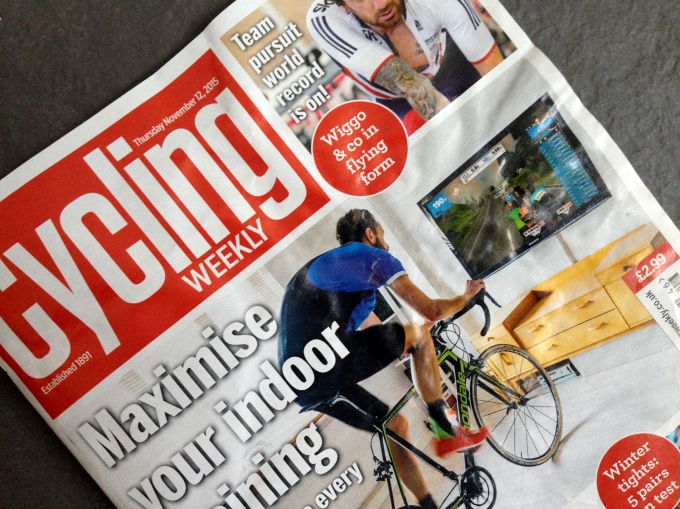It may seem rather churlish to mock and complain about websites that are basically supplying content free of charge. But that isn’t going to stop me. Oh no. Churlish is my middle name. And just because something is free that doesn’t mean it shouldn’t be any good. This blog is free, and it’s excellent.
But the problem with the internet, as opposed to Old Skool publishing, is that it has become a numbers game. More hits equals more advertising revenue. That’s it. There’s no way of telling whether the clicks come from a bloke on the dole interested in cheap transport or from a Rapha-clad merchant banker looking for another £7000 bike to add to his collection. In print media, the advertisers pretty much know what they’re getting — The Daily Telegraph will deliver 500,000 ABC1 readers with an average age of 55. The Sun will deliver two million van drivers aged under 40. But the interweb can’t differentiate…your IP address doesn’t have a socio-economic profile (actually, it probably does, but you know what I mean). Sure, the Rouleur website is going to deliver a very different type of reader to the RideUKBMX website, but in the middle of the mainstream it’s more difficult to work out the readership demographic.
As a result, websites often just use the number of hits and/or unique users as a way of persuading advertisers to come on board. So hits and traffic become all-important..welcome to the world of click-bait and listicles
Listicles (articles that are basically just lists) are a churnalists best-friend. They’re quick to produce and simple enough for even the lowliest-paid keyboard-monkey to bosh out in an hour or so. And mostly they don’t even have to contain any verifiable facts. Take this one from today’s BikeRadar: 25 Signs You’re a Cyclist for Life. This is one of those listicles that requires no research or facts, nor even the ability to write well, just some wry observational comedy (and I use the word comedy advisedly) designed to reassure us that everyone else is as obsessive as we are.
Over at RoadCyclingUK it’s listicle central (in the spirit of RCUK, I’ve done it as a list):
- 30 Inspirational cycling quotes
- 15 most popular must-ride Strava segments
- 10 Most successful British male cyclists of all time
- 8 steps to create your perfect winter training programme
- 6 ways to beat a headwind
- 6 things you need to know about detraining
- 5 best (and worst) team kits of all time
- and a partridge in a fucking pear tree
And that’s just on their homepage. Seriously, seven listicles on the home page. Tragic. They aren’t alone in this, but they are definitely the worst offenders.
Click-bait is the other technique used for driving traffic. And the more buzz-words you can get in the headline the better: Naked Cyclist in Road-Rage Fury…You Won’t Believe What Happened Next! Or, in the case of BikeRadar this morning: Could pedal-power solve the world’s energy crisis? And: This invention promises to stop car doors taking out cyclists.
The energy crisis story is a useful illustration of content churn. Pre-interweb, the news editor would have read the press release, given it two minutes thought, and then thrown it in the bin and moved on to something genuinely news-worthy. But these days the web guys are expected to post a certain number of new stories on the site each day, so something like this is heaven-sent. Top and tail the press release, bung a click-bait headline on it, and the job’s a good ‘un. There’s no attempt at critical appraisal (too time-consuming). Besides, the readers can do that in the comments section below (which also drives traffic).
I have an issue with the car door story, too. As cyclists we get fed up with the way the mainstream press covers accidents involving cyclists. The classic line is “cyclist suffers life-changing injuries after colliding with car”. The implication being that the cyclist ran into the car, and also that the car is somehow driverless. It should read (in most cases) “driver inflicts life-changing injuries on cyclist”. But we never get that. And this story on BikeRadar does the same thing, by implying that somehow it’s car doors that are injuring cyclists, rather than the people operating the car without due care. You’d expect a cycling website to be more careful.
So, which cycling websites are worth your time?
BikeRadar — a huge site with sections dedicated to road, MTB, urban and women. There’s a lot on here in terms of news and features, even if most of it is pretty lightweight. The forums are particularly popular and get a lot more traffic than any of the other mainstream UK cycling websites.
RoadCC — aimed at a rather more grown-up audience than the others, RoadCC is unusual in that it doesn’t have any print products to promote. The result is a site that feels a bit more considered and a bit less hysterical than the others. The forums, too, are a bit more grown-up, although they don’t get the same volume of traffic as BikeRadar.
RoadCyclingUK — this is one of 20 or so adventure-sport sites run by Factory Media and feels very much the poor relation to the other mainstream cycling sites. There is a sense of desperation surrounding their listicles and click-bait and it feels far less self-assured than the others. Interestingly, their TotalWomensCycling site feels rather better, even if they do love a list.
Cyclingnews — this is the go-to place for racing news. Run by Immediate Media (the people who bring you BikeRadar and Cycling Plus), this is serious racing news, and as such I only ever go there if I’m alerted to something particularly interesting by Twitter. Their over (and incorrect) use of the word “exclusive” gets on my tits, but that’s all part of the effort to drive traffic.
CyclingWeekly — website of The Comic, this is a mix of racing and recreational cycling news and features. The racing stuff is mostly the same as on CyclingNews, and the recreational stuff is mostly re-purposed content from their print editions (Cycling Weekly, Cycling Active, and Mountain Bike Rider). But for all that, the site is well laid-out, has fairly decent content, and avoids the hysteria and click-baitery of other cycling websites.
Cyclist — the website of the magazine, it mixes news with content from previous issues of the magazine to create quite a nice site. It’s definitely one for the grown-ups and the fat-of-wallet, but has a considered and mature feel. A few too many “sponsored” bike pieces for my liking, but at least they’re up front about them.
Rouleur — this is where I go for my lunchtime reading. This isn’t the place for a 10 Best Winter Cycling Lights feature, but it is a place to go for considered, well-written journalism and features about the weird and wonderful of road-racing. They assume that the reader is capable of reading more than 150 words at one time, and that they are capable of getting through the day without being spoon-fed vacuous shite.
I could go on, but you’ve probably had enough of this by now. Suffice to say, the advent of free online content is a very mixed blessing. The rates of pay for churnalists are absolutely shocking, so it’s unsurprising that in general the content is pretty poor. I won’t tell you what I got paid by The Guardian website recently, but it wasn’t a lot (it was still more than double what some cycling websites pay).
Articles repurposed from print editions tend to be better quality, if only because they are usually written by qualified professionals and subbed by someone other than the author. Even then there is no guarantee, because some cycling magazines generate an awful lot of bollocks.
There will be no blog tomorrow as I’m off to the motorbike show at the NEC, where I expect to add to my stable with a 1299 Panigale.















